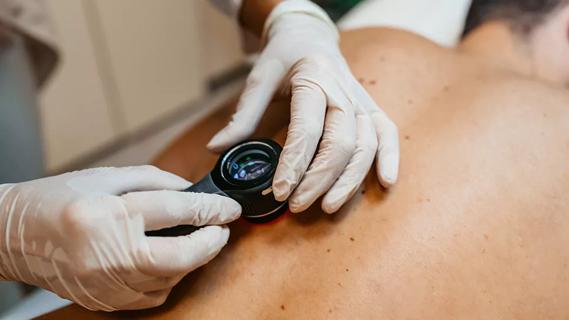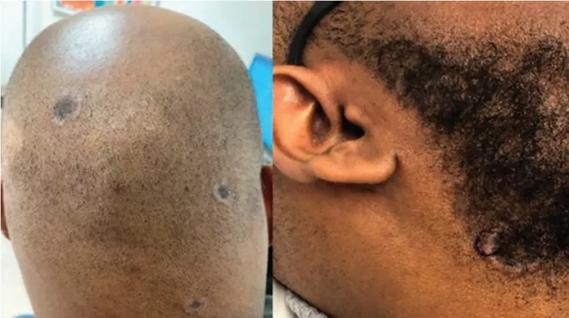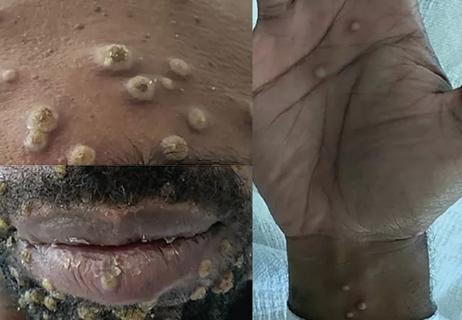How to recognize and treat the disease, and field patient questions

Breast implant-associated anaplastic large cell lymphoma (BIA-ALCL) is a rare subtype of T-cell lymphoma that develops in tissue adjacent to breast implants. It typically presents as breast swelling approximately 2 to 10 years (mean of 8-9 years) after implant insertion. The swelling may be secondary to periprosthetic seroma formation or, more rarely, palpable disease in the breast or in the axilla. Patients occasionally complain of pain and rarely, constitutional symptoms.
Advertisement
Cleveland Clinic is a non-profit academic medical center. Advertising on our site helps support our mission. We do not endorse non-Cleveland Clinic products or services. Policy
“Globally, there are about 35 million patients with breast implants. Most of these patients will not develop BIA-ALCL, but very few may,” says Andrea Moreira, MD, a board-certified plastic surgeon at the Cleveland Clinic Dermatology & Plastic Surgery Institute. “After implant surgery, it is recommended that patients continue to follow up with their plastic surgeon. However, we know that most patients are not necessarily seen by a breast surgeon or a plastic surgeon on a regular basis. Instead, they are more likely to be followed by their primary care physicians or gynecologists. A lack of knowledge about BIA-ALCL might mean that physicians disregard patient complaints of slight swelling or minor discomfort, especially if it has been years or decades since the implant surgery. Additionally, this issue [BIA-ALCL] has been in the news media. If a patient with a breast implant presents with questions, it’s a good idea to have all the facts.”
BIA-ALCL is not a disease of the surrounding breast tissue, but rather of the fibrous periprosthetic capsule. “Every time you implant a device,” Dr. Moreira explains, “a layer of tissue develops — called capsule — around the device to separate it from the rest of the body. It’s almost like a thin layer of scar tissue around the device.”
BIA-ALCL is associated with textured breast implants. “We don’t know if it’s only the texturization of the implant that causes these changes or if there are other factors. We think perhaps there’s more than one factor, perhaps genetic or bacterial. Whatever the cause, over time it seems this chronic inflammation can lead to the development of a low-grade lymphoma,” she says.
Advertisement
The risk of developing BIA-ALCL is varied – anywhere from 1:2,207 to 1:86,209 – depending on the variable risk with different textured implants developed by different manufacturers. The U.S. Food & Drug Administration (FDA) actually recalled the textured implants and expanders from one company in September 2019, which had a disproportionately high incidence of BIA-ALCL; however, not all textured implants from all device makers have been recalled. The first case was reported in 1997, and as of February 21, 2020, there were 888 cases worldwide. It is important to continue to track the development of the disease, and to continue patient education and outreach efforts, says Dr. Moreira.
In order to develop a more comprehensive understanding of the extent of the disease, the American Board of Plastic Surgeons has developed a Patient Registry and Outcomes for Breast Implants and Anaplastic Large Cell Lymphoma Etiology and Epidemiology (PROFILE). Currently, plastic surgeons are advised to discuss the risk of BIA-ALCL with all patients at the time of breast augmentation consultation and to report all confirmed cases to the PROFILE registry.
Developed in the 1980s, texturing the surface of the breast implant was thought to disrupt capsule formation around the prosthesis, somewhat reducing the risk of capsular contracture compared to saline implants. “Textured devices were also developed because the texture stabilizes the implant in the breast pocket, reducing malposition,” adds Dr. Moreira. “We stopped using them [textured implants] in 2018; we felt it was not in our patient’s best interest to continue to offer them. There are too many unknowns, and until we know exactly what is causing BIA-ALCL, the best decision at this time is to avoid the use of textured implants.”
Advertisement
Patients often present with a seroma or swelling of the breast. Diagnosis is confirmed by ultrasonographically guided fine-needle aspiration of seroma fluid and subsequent immunohistochemical testing for CD30-positive and ALK-negative T lymphocytes. Treatment involves implant removal and total capsulectomy, which is done “en bloc” at Cleveland Clinic, with samples sent for pathology study with cyokeratin staining. Of note, in cases of BIA-ALCL in which the disease was limited to the circumscribed scar tissue of the breast capsule, complete surgical excision is curative, whereas incomplete capsulectomy portends a greater risk of recurrence and decreased survival.
“A small number of patients will need chemotherapy, with most patients undergoing complete remission. Of course, patients with a mass or patients with have systemic disease may have a less positive prognosis, but that is a very small number of patients,” says Dr. Moreira.
It’s very important for patients to know that they have a local resource,” Dr. Moreira notes. “At Cleveland Clinic, we created a protocol and streamlined the treatment for these patients. We have seen many patients with textured implants who are, of course, very concerned. The concerns can be heightened in women who opted for reconstruction following mastectomy. In 2018, we sent all of our patients a letter that provided them with all the information we had available at that time, and asked them to come back to be evaluated. We developed a hotline with trained nurses who are able to answer all the questions about the disease.”
Advertisement
“We know that the risk for patients with smooth implants is pretty low. For these patients, we provide reassurance. For the patients with textured devices, we are bringing them back and to discuss what can be done. Right now, the FDA recommends annual follow-up with a physician who has knowledge of BIA-ALCL. If there’s fluid around the implant, we like to collect that for preventive cytology. If there are any issues with the capsule, we like to remove it.”
“In patients with textured implants but no sign of disease, there is no proven benefit of “en bloc” resection at this point. However, these patients may prefer to have the textured implant removed, with reconstruction via silicone implant or fat grafting. These reconstruction methods are also usually available for women who develop BIA-ALCL, once pathology confirms the patient is free of disease.”
Advertisement
Advertisement

Family history may eclipse sun exposure in some cases

Consider secondary syphilis in the differential of annular lesions

Persistent rectal pain leads to diffuse pustules

Two cases — both tremendously different in their level of complexity — illustrate the core principles of nasal reconstruction

Stress and immunosuppression can trigger reactivation of latent virus

Low-dose, monitored prescription therapy demonstrates success

Antioxidants, barrier-enhancing agents can improve thinning hair